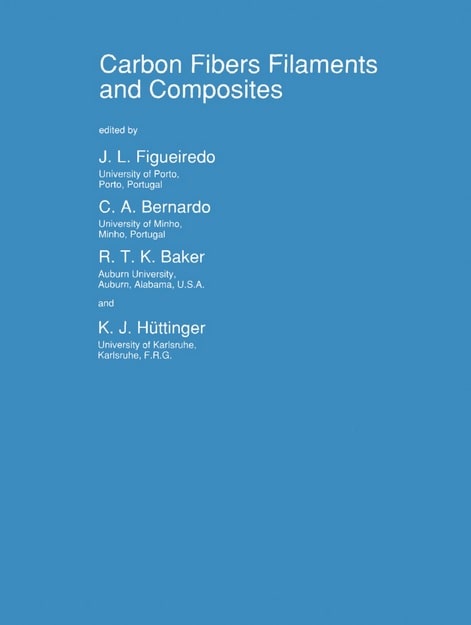
TABLE OF CONTENTS
Preface
Organizing Committee and Lecturers
List of Contributors
Part I. Fibres
E. Fitzer
Carbon fibers – present state and future expectations
D.D.Edie
Pitch and mesophase fibers
G.G. Tibbetts
Vapor-grown carbon fibers
P. Gade1le
The growth of vapor-deposited carbon fibres
DJ. Johnson
Structure and properties of carbon fibres
P. Ehrburger
Surface properties of carbon fibres
D.D. Edie
Critical issues for carbon fibers
Part ll. Composites
E. Fitzer
Carbon fibres and composites
W. HUttner, R. Weiss
High performance carbon fibre composites with thermoplastic matrices
KJ. HUttinger
The fundamentals of chemical interactions in composite interfaces
W. Weisweiler, K. Schlitter
Surface modification of carbon fibres by plasma polymerization
W. HUttner
Potential of carbon/carbon composites as structural materials 275
KJ. HUttinger
Theoretical and practical aspects of liquid-phase pyrolysis as basis of the carbon matrix of
CFRC 301
P. Ehrburger
Protective layers for special types of composites 327
W. Hiittner, L.E. Claes
Carbon based materials in medical applications 337
B. Rand, R.J. Zeng
Fibre reinforced ceramic-matrix composites 367
B. Rand
Critical issues concerning carbon fibre reinforced composites 399
Part III. Filaments
R.T.K. Baker
Electron microscopy studies of the catalytic growth of carbon filaments 405
J.L. Figueiredo, C.A. Bernardo
Filamentous carbon formation on metals and alloys 441
A. Sacco, Jf.
Carbon deposition and filament initiation and growth mechanisms on iron particles and foils 459
L. Bonnetain, P. OadcIIe, M. Audier
Structural characterization of filamentous carbons produced on metal catalysts 507
0.0. Tibbetts
Physical modeling of carbon filament growth
N.M. Rodriguez, M.S. Kim, W.B. Downs, R.T.K. Baker
Applications of carbon filaments
0.0. Tibbetts
Carbon filaments
List of lectures and participants
Subject index
Preface
Conventional synthetic materials, like metals, ceramics or glass, are usually isotropic substances, and their suitability for structural applications is achieved by morphological design and combination in the macroscopic scale. However, in modem engineering this is often not acceptable. As an alternative, the use of non-homogeneous, anisotropic materials, with significant stiffness and strength only in the directions these mechanical properties are really needed, can lead to enormous material (and weight) savings. This is the case of multiphase systems called composite materials. In these composites, different material parts are added and arranged geometrically, under clearly designed and controlled conditions. Usually, a structure of fibers provides strength and stiffness and a matrix helds them together, whilst providing the geometric form.
Carbon fibers are among the high-performance fibers employed in these advanced structural composites, which are profoundly changing many of today’s high technology industries. New research and development challenges in this area include upgrading the manufacturing process of fibers and composites, in order to improve characteristics and reduce costs, and modifying the interfacial properties between fibers and matrix, to guarantee better mechanical properties.
The interdisciplinary nature of this “new frontier” is obvious, involving chemistry, materials science, chemical and mechanical engineering. Other topics, which more often are treated separately, are also important for the understanding of the processes of fiber production. Carbon filaments is one such topic, as the study of their mechanisms of nucleation and growth is clearly quite relevant to the production of vapour-grown carbon fibers.
For this reason, it was considered appropriate that recognised world experts, actively involved in research, development and design in the field of carbon fibers and filaments, should meet and exchange ideas and experiences. Such a meeting was held at Alvor, Portugal, from 15 to 27 May, 1989, under the sponsorship of the NATO Advanced Study Institutes Programme.
This Advanced Study Institute was organized into three main sections, devoted to carbon fibers, composites and filaments, respectively. In each section, the whole field was reviewed from the basic concepts to the frontiers of present knowledge, integrating a coherent set of lectures. At the end of each section, a general debate was held to systematize the subject and to identify areas of required research.
The present book is organized in a similar way. The first part, dedicated to carbon fibers, contains six lectures presenting the state of the art in the production, characterization and applications of PAN- based, pitch and mesophase-based and gasphase grown carbon fibers. In the second part, composites with polymeric (thermoplastic and thermosetting resins), carbon and ceramic matrices are studied. Special attention is given to the fiber-matrix interface, and medical applications of carbon-based materials are also reviewed. The third section deals with the formation of filamentous carbon catalysed by metals such as nickel, iron and alloys. Conflicting views on the mechanism of filament growth are discussed in detail. In addition, novel and potentially interesting applications of these filaments as engineering materials are presented. At the end of each section there is a summary of the debates held during the Institute, written in chapter form by their respective co-ordinators.
The editors would like to express their gratitude to all speakers and participants for their active contributions which made the Institute and this book possible, and to the Scientific Affairs Division of NATO for the financial support that was in the basis of it all. Additional support was provided by the Universities of Porto and Minho, Junta Nacional de Investigll¥lio Cientffica e Tecnol6gica, Instituto Nacional de Investiga9lio Cientffica and the Calouste Gulbenkian Foundation, and is gratefully acknowledged.
